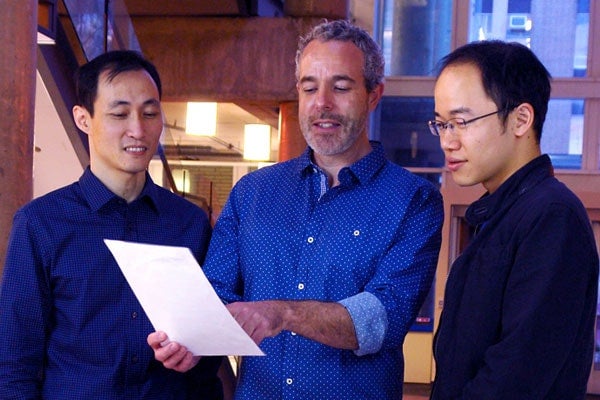
Machine learning reveals unexpected genetic roots of cancers, autism and other disorders
Published: December 18, 2014
In the decade since the genome was sequenced in 2003, scientists, engineers and doctors have struggled to answer an all-consuming question: Which DNA mutations cause disease?
A new computational technique developed at the University of Toronto may now be able to tell us.
A Canadian research team led by Professor Brendan Frey has developed the first method for ‘ranking’ genetic mutations based on how living cells ‘read’ DNA, revealing how likely any given alteration is to cause disease. They used their method to discover unexpected genetic determinants of autism, hereditary cancers and spinal muscular atrophy, a leading genetic cause of infant mortality.
Their findings appear in the December 18 issue of the leading journal Science and are already grabbing headlines. (Read the article in Quanta Magazine; read the Globe and Mail story; see coverage at autismspeaks.org.)
Think of the human genome as a mysterious text, made up of three billion letters.
“Over the past decade, a huge amount of effort has been invested into searching for mutations in the genome that cause disease, without a rational approach to understanding why they cause disease,” said Frey. “This is because scientists didn’t have the means to understand the text of the genome and how mutations in it can change the meaning of that text.”
It's a puzzle that Frey points out was captured by biologist Eric Lander of the Massachusetts Institute of Technology in a famous quote: “Genome. Bought the book. Hard to read.”
 What was Frey’s approach? Scientists know that certain sections of the text, called exons, describe the proteins that are the building blocks of all living cells. What wasn’t appreciated until recently is that other sections, called introns, contain instructions for how to cut and paste exons together, determining which proteins will be produced. This ‘splicing’ process is a crucial step in the cell’s process of converting DNA into proteins, and its disruption is known to contribute to many diseases.
What was Frey’s approach? Scientists know that certain sections of the text, called exons, describe the proteins that are the building blocks of all living cells. What wasn’t appreciated until recently is that other sections, called introns, contain instructions for how to cut and paste exons together, determining which proteins will be produced. This ‘splicing’ process is a crucial step in the cell’s process of converting DNA into proteins, and its disruption is known to contribute to many diseases.
(Image at right: artist’s conception of how disease-causing genetic mutations reside with long chains of DNA; photo by Jessica Wilson.)
Most research into the genetic roots of disease has focused on mutations within exons, but increasingly scientists are finding that diseases can’t be explained by these mutations. Frey’s team took a completely different approach, examining changes to text that provides instructions for splicing, most of which is in introns.
Frey’s team used a new technology called ‘deep learning’ to teach a computer system to scan a piece of DNA, read the genetic instructions that specify how to splice together sections that code for proteins, and determine which proteins will be produced.
Unlike other machine learning methods, deep learning can make sense of incredibly complex relationships, such as those found in living systems in biology and medicine.
“The success of our project relied crucially on using the latest deep learning methods to analyze the most advanced experimental biology data,” said Frey, whose team included members from U of T’s Faculty of Applied Science & Engineering, Faculty of Medicine and the Terrence Donnelly Centre for Cellular and Biomolecular Research, as well as Microsoft Research and the Cold Spring Harbor Laboratory.
“My collaborators and our graduate students and postdoctoral fellows are world-leading experts in these areas.”
Once they had taught their system how to read the text of the genome, Frey’s team used it to search for mutations that cause splicing to go wrong. They found that their method correctly predicted 94 per cent of the genetic culprits behind well-studied diseases such as spinal muscular atrophy and colorectal cancer, but more importantly, made accurate predictions for mutations that had never been seen before.
They then launched a huge effort to tackle a condition with complex genetic underpinnings: autism spectrum disorder.
“With autism there are only a few dozen genes definitely known to be involved and these account for a small proportion of individuals with this condition,” said Frey.
In collaboration with Dr. Stephen Scherer, senior scientist and director of the University of Toronto McLaughlin Centre and The Centre for Applied Genomics at SickKids, Frey’s team compared mutations discovered in the whole genome sequences of children with autism, but not in controls. Following the traditional approach of studying protein-coding regions, they found no differences. However, when they used their deep learning system to rank mutations according to how much they change splicing, surprising patterns appeared.
“When we ranked mutations using our method, striking patterns emerged, revealing 39 novel genes having a potential role in autism susceptibility,” Frey said.
And autism is just the beginning – this mutation indexing method is ready to be applied to any number of diseases, and even non-disease traits that differ between individuals.
Dr. Juan Valcárcel Juárez, a researcher with the Center for Genomic Regulation in Barcelona, Spain, who was not involved in this research, said: “In a way it is like having a language translator: it allows you to understand another language, even if full command of that language will require that you also study the underlying grammar. The work provides important information for personalized medicine, clearly a key component of future therapies.”



